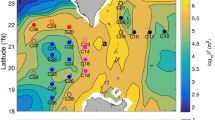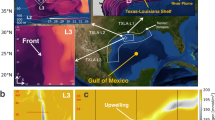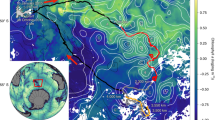Abstract
The overturning circulation of the ocean plays an important role in modulating the Earth's climate. But whereas the mechanisms for the vertical transport of water into the deep ocean—deep water formation at high latitudes—and horizontal transport in ocean currents have been largely identified, it is not clear how the compensating vertical transport of water from the depths to the surface is accomplished. Turbulent mixing across surfaces of constant density is the only viable mechanism for reducing the density of the water and enabling it to rise. However, measurements of the internal wave field, the main source of energy for mixing, and of turbulent dissipation rates, have typically implied diffusivities across surfaces of equal density of only ∼0.1 cm2 s-1, too small to account for the return flow. Here we report measurements of tracer dispersion and turbulent energy dissipation in the Brazil basin that reveal diffusivities of 2–4 cm2 s-1 at a depth of 500 m above abyssal hills on the flank of the Mid-Atlantic Ridge, and approximately 10 cm2 s-1 nearer the bottom. This amount of mixing, probably driven by breaking internal waves that are generated by tidal currents flowing over the rough bathymetry, may be large enough to close the buoyancy budget for the Brazil basin and suggests a mechanism for closing the global overturning circulation.
This is a preview of subscription content, access via your institution
Access options
Subscribe to this journal
Receive 51 print issues and online access
$199.00 per year
only $3.90 per issue
Buy this article
- Purchase on Springer Link
- Instant access to full article PDF
Prices may be subject to local taxes which are calculated during checkout





Similar content being viewed by others
References
Gregg, M. C. Scaling turbulent dissipation in the thermocline. J. Geophys. Res. 94, 9689–9698 (1989).
Toole, J. M., Polzin, K. L. & Schmitt, R. W. Estimates of diapycnal mixing in the abyssal ocean. Science 264, 1120–1123 (1994).
Polzin, K., Toole, J. & Schmitt, R. Finescale parameterizations of turbulent dissipation. J. Phys. Oceanogr. 25, 306–328 (1995).
Hogg, N., Biscaye, P., Gardner, W. & Schmitz, W. J. Jr On transport and modification of Antarctic bottom water in the Vema Channel. J. Mar. Res. (Suppl.) 40, 231–263 (1982).
Morris, M., Hogg, N. & Owens, W. B. Diapycnal mixing estimated from advective budgets in the deep Brazil Basin. Int. WOCE Newslett. 28, 23–25 (1997).
Polzin, K. L., Toole, J. M., Ledwell, J. R. & Schmitt, R. W. Spatial variability of turbulent mixing in the abyssal ocean. Science 276, 93–96 (1997).
Ledwell, J. R., Watson, A. J. & Law, C. S. Mixing of a tracer in the pycnocline. J. Geophys. Res. 103, 21499–21529 (1998).
Bell, T. H. Lee waves in stratified flows with simple harmonic time dependence. J. Fluid Mech. 67, 705–722 (1975).
Polzin, K. L. Inertial subrange solutions for the energy balance of the finescale internal wavefield. J. Mar. Res. (submitted).
Langseth, M. G. & Hobart, M. A. Interpretation of heat flow measurements in the Vema Fracture Zone. Geophys. Res. Lett. 3, 241–244 (1976).
Ledwell, J. R. & Bratkovich, A. A tracer study of mixing in the Santa Cruz Basin. J. Geophys. Res. 100, 20681–20704 (1995).
Schmitt, R. W., Toole, J. M., Koehler, R. L., Mellinger, E. C. & Doherty, K. W. The development of a fine- and microstructure profiler. J. Atmos. Ocean. Tech. 5, 484–500 (1988).
Polzin, K. L. & Montgomery, E. T. in Proc. Microstructure Sensors Workshop (eds Agrawal, Y., Williams, A. & Goodman, L.) 109–115 (Sequoia Scientific Inc., Mercer Island, Washington 98040, USA, 1997).
Bell, T. H., Jr. Topographically generated internal waves in the open ocean. J. Geophys. Res. 80, 320–327 (1975).
Egbert, G. D., Bennet, A. F. & Foreman, M. G. G. TOPEX/POSEIDON tides estimated using a global inverse model. J. Geophys. Res. 99, 24821–24852 (1994).
Smith, W. H. F. & Sandwell, D. T. Bathymetric prediction from dense altimetry and sparse shipboard bathymetry. J. Geophys. Res. 99, 21803–21824 (1994).
Osborn, T. R. Estimates of the local rate of vertical diffusion from dissipation measurements. J. Phys. Oceanogr. 10, 83–89 (1980).
Acknowledgements
Our research is funded by the US National Science Foundation. We thank our technical associates and the officers and crew of the RV Seward Johnson for their support.
Author information
Authors and Affiliations
Corresponding author
Rights and permissions
About this article
Cite this article
Ledwell, J., Montgomery, E., Polzin, K. et al. Evidence for enhanced mixing over rough topography in the abyssal ocean. Nature 403, 179–182 (2000). https://doi.org/10.1038/35003164
Received:
Accepted:
Issue Date:
DOI: https://doi.org/10.1038/35003164
This article is cited by
-
Widespread global disparities between modelled and observed mid-depth ocean currents
Nature Communications (2023)
-
Interannual variability of internal tides in the Andaman Sea: an effect of Indian Ocean Dipole
Scientific Reports (2022)
-
Diagnostic evaluation of effects of vertical mixing on meridional overturning circulation in an idealized ocean
Journal of Oceanography (2021)
-
Internal wave-driven mixing: governing processes and consequences for climate
Nature Reviews Earth & Environment (2020)
-
Role of internal tide mixing in keeping the deep Andaman Sea warmer than the Bay of Bengal
Scientific Reports (2020)
Comments
By submitting a comment you agree to abide by our Terms and Community Guidelines. If you find something abusive or that does not comply with our terms or guidelines please flag it as inappropriate.



